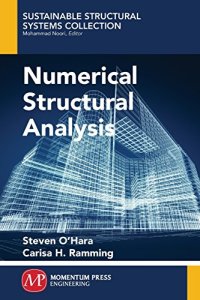
Ebook: Numerical structural analysis
Author: O'Hara Steven E., Ramming Carisa H
- Tags: Structural analysis (Engineering) -- Mathematical models. TECHNOLOGY & ENGINEERING / Civil / General adjoint matrix algebraic equations area moment beam deflection carry- over factor castigliano's theorems cofactor matrix column matrix complex conjugate pairs complex roots
- Series: Sustainable structural systems collection
- Year: 2015
- Publisher: Momentum Press
- Language: English
- pdf
As structural engineers move further into the age of digital computation and rely more heavily on computers to solve problems, it remains paramount that they understand the basic mathematics and engineering principles used to design and analyze building structures. The link between the basic concepts and application
to real world problems is one of the most challenging learning endeavors that structural engineers face. The primary purpose of Numerical Structural Analysis is to assist structural engineering students with developing the ability to solve complex structural analysis problems. This book will cover numerical techniques to solve mathematical formulations, which are necessary in developing the analysis procedures for structural engineering. Once the numerical formulations are understood, engineers can then develop structural analysis methods that use these techniques. This will be done primarily with matrix structural stiffness procedures. Finally, advanced stiffness topics will be developed and presented to solve unique structural problems, including member end releases, non-prismatic, shear, geometric, and torsional stiffness.
to real world problems is one of the most challenging learning endeavors that structural engineers face. The primary purpose of Numerical Structural Analysis is to assist structural engineering students with developing the ability to solve complex structural analysis problems. This book will cover numerical techniques to solve mathematical formulations, which are necessary in developing the analysis procedures for structural engineering. Once the numerical formulations are understood, engineers can then develop structural analysis methods that use these techniques. This will be done primarily with matrix structural stiffness procedures. Finally, advanced stiffness topics will be developed and presented to solve unique structural problems, including member end releases, non-prismatic, shear, geometric, and torsional stiffness.
Download the book Numerical structural analysis for free or read online
Continue reading on any device:

Last viewed books
Related books
{related-news}
Comments (0)